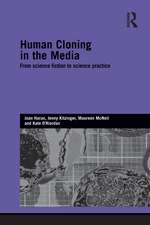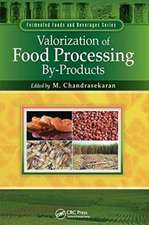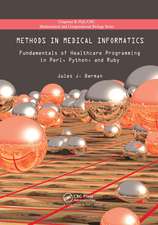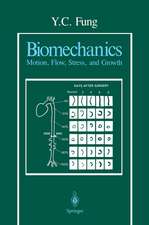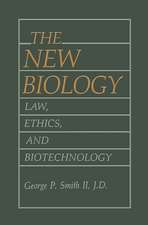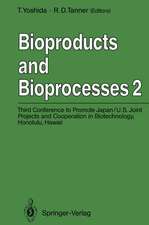Enzymes for Solving Humankind's Problems: Natural and Artificial Systems in Health, Agriculture, Environment and Energy
Editat de José J. G. Moura, Isabel Moura, Luisa B. Maiaen Limba Engleză Paperback – 3 dec 2021
Chapters from expert contributors explore how natural enzymes and artificial systems tackle specific targets such as: climate change, carbon footprint and economy and carbon dioxide utilisation; nitrogen footprint and fixation and nitrous oxide mitigation; hydrogen production, fuel cells and energy from bacteria; biomass transformation and production of added-value compounds, as well as biosensors development.
This book provides an important and inspiring account for the designing of new natural and artificial systems with enhanced properties, and it appeals not only to students and researchers working in the fields of energy, health, food and environment, but also to a wider audience of educated readers that are interested in these up-to-date and exciting subjects.
Chapter “Carbon Dioxide Utilisation—The Formate Route” is available open access under a Creative Commons Attribution 4.0 International License via link.springer.com.
| Toate formatele și edițiile | Preț | Express |
|---|---|---|
| Paperback (1) | 954.93 lei 6-8 săpt. | |
| Springer International Publishing – 3 dec 2021 | 954.93 lei 6-8 săpt. | |
| Hardback (1) | 961.23 lei 6-8 săpt. | |
| Springer International Publishing – 2 dec 2020 | 961.23 lei 6-8 săpt. |
Preț: 954.93 lei
Preț vechi: 1164.56 lei
-18% Nou
Puncte Express: 1432
Preț estimativ în valută:
182.75€ • 190.09$ • 150.87£
182.75€ • 190.09$ • 150.87£
Carte tipărită la comandă
Livrare economică 14-28 aprilie
Preluare comenzi: 021 569.72.76
Specificații
ISBN-13: 9783030583170
ISBN-10: 3030583171
Ilustrații: X, 506 p. 141 illus., 114 illus. in color.
Dimensiuni: 155 x 235 mm
Greutate: 0.72 kg
Ediția:1st ed. 2021
Editura: Springer International Publishing
Colecția Springer
Locul publicării:Cham, Switzerland
ISBN-10: 3030583171
Ilustrații: X, 506 p. 141 illus., 114 illus. in color.
Dimensiuni: 155 x 235 mm
Greutate: 0.72 kg
Ediția:1st ed. 2021
Editura: Springer International Publishing
Colecția Springer
Locul publicării:Cham, Switzerland
Cuprins
A general overview of the subject.- State-of-art of the utilization of natural and artificial systems in general problems that affect the human life and society.- Hydrogen production (natural systems).- Hydrogen production (artificial systems).- Carbon footprint (carbon dioxide economy).- Carbon dioxide utilisation - general overview.- Carbon dioxide utilisation - bioelectrochemical approaches.- Methane production.- Methane oxidation.- Biomass transformation and production of added-value compounds.- Biocatalysis for the production of added-value compounds.- Nitrogen footprint.- Nitrogen fixation and agriculture.- Reversing nitrogen fixation.- Nitrous oxide emission under control.- Oxygen splitting and photosynthesis.- Enzymatic Biofuel Cells.- Energy from bacteria.- Interspecies Electron Transfer.- Biocatalysis and pharmaceuticals.- Proteins, peptides and enzymes in our lives.
Notă biografică
José J. G. Moura is a Professor at the Department of Chemistry (LAQV, REQUIMTE), NOVA School of Science and Technology (Portugal), and his main research focuses on Bioinorganic Chemistry and the role of metals in Biology. He was previously a Research Specialist at the University of Minnesota (USA) and an Adjunct Professor at the University of Georgia, Athens (USA). He is also the Past President of the Chemistry Department and President of the Scientific Council at NOVA School of Science and Technology, a Portuguese Delegate to COST and INTAS, a member of Scientific Panel in the Calouste Gulbenkian Foundation and Portuguese National Grant Agency (FCT/MCTES), NST (US) Specialized Panel, and of several scientific editorial boards. In 2006, he was elected member of Academia das Ciências de Lisboa and, in 2010, elected President of the Society of Biological Inorganic Chemistry, for 2 years. He is also Director and Curator of FCT Library.
Isabel Moura is a Professor at the Department of Chemistry (LAQV, REQUIMTE), NOVA School of Science and Technology (Portugal), and her main research interests include structure-function of metalloproteins; application of biochemical and spectroscopic tools (NMR, EPR and Mössbauer); proteins involved in relevant bacterial metabolic pathways – nitrogen and sulfur biocycles; active sites containing copper, cobalt, haems, iron–sulfur centres; association of iron-sulfur centres with molybdenum, tungsten, nickel, sirohaem and flavins; and new type of clusters and new metal associations. She was previously a Visiting Professor at the University of Georgia, Athens (USA). During the period 2000/2011, she was the Head of the Chemistry Department of NOVA School of Science and Technology (Portugal) and the Director of the Associated Laboratory REQUIMTE for Sustainable Chemistry.
Luisa B. Maia holds a Ph.D. degree in Pharmaceutical and Clinical Biochemistry and presently is an Assistant Researcher at LAQV, REQUIMTE, NOVA School of Science and Technology (Portugal). She has a long-standing interest in reactive oxygen and nitrogen species and structure-activity relationships in metalloenzymes, having contributed to the elucidation of the mechanism of action of enzymes relevant to Human Health & Disease and also Climate/Bioenergy. Her recent efforts have been dedicated to the study of the novel human nitrate-nitrite-nitric oxide pathway, as well as, of bacterial enzymatic systems to convert carbon dioxide into added-value compounds.
Isabel Moura is a Professor at the Department of Chemistry (LAQV, REQUIMTE), NOVA School of Science and Technology (Portugal), and her main research interests include structure-function of metalloproteins; application of biochemical and spectroscopic tools (NMR, EPR and Mössbauer); proteins involved in relevant bacterial metabolic pathways – nitrogen and sulfur biocycles; active sites containing copper, cobalt, haems, iron–sulfur centres; association of iron-sulfur centres with molybdenum, tungsten, nickel, sirohaem and flavins; and new type of clusters and new metal associations. She was previously a Visiting Professor at the University of Georgia, Athens (USA). During the period 2000/2011, she was the Head of the Chemistry Department of NOVA School of Science and Technology (Portugal) and the Director of the Associated Laboratory REQUIMTE for Sustainable Chemistry.
Luisa B. Maia holds a Ph.D. degree in Pharmaceutical and Clinical Biochemistry and presently is an Assistant Researcher at LAQV, REQUIMTE, NOVA School of Science and Technology (Portugal). She has a long-standing interest in reactive oxygen and nitrogen species and structure-activity relationships in metalloenzymes, having contributed to the elucidation of the mechanism of action of enzymes relevant to Human Health & Disease and also Climate/Bioenergy. Her recent efforts have been dedicated to the study of the novel human nitrate-nitrite-nitric oxide pathway, as well as, of bacterial enzymatic systems to convert carbon dioxide into added-value compounds.
Textul de pe ultima copertă
This book presents specific key natural and artificial systems that are promising biocatalysts in the areas of health, agriculture, environment and energy. It provides a comprehensive account of the state of the art of these systems and outlines the significant progress made in the last decade using these systems to develop innovative, sustainable and environmentally friendly solutions.
Chapters from expert contributors explore how natural enzymes and artificial systems tackle specific targets such as: climate change, carbon footprint and economy and carbon dioxide utilisation; nitrogen footprint and fixation and nitrous oxide mitigation; hydrogen production, fuel cells and energy from bacteria; biomass transformation and production of added-value compounds, as well as biosensors development.
This book provides an important and inspiring account for the designing of new natural and artificial systems with enhanced properties, and it appeals not only to students and researchers working in the fields of energy, health, food and environment, but also to a wider audience of educated readers that are interested in these up-to-date and exciting subjects.Chapter “Carbon Dioxide Utilisation—The Formate Route” is available open access under a Creative Commons Attribution 4.0 International License via link.springer.com.
Chapters from expert contributors explore how natural enzymes and artificial systems tackle specific targets such as: climate change, carbon footprint and economy and carbon dioxide utilisation; nitrogen footprint and fixation and nitrous oxide mitigation; hydrogen production, fuel cells and energy from bacteria; biomass transformation and production of added-value compounds, as well as biosensors development.
This book provides an important and inspiring account for the designing of new natural and artificial systems with enhanced properties, and it appeals not only to students and researchers working in the fields of energy, health, food and environment, but also to a wider audience of educated readers that are interested in these up-to-date and exciting subjects.Chapter “Carbon Dioxide Utilisation—The Formate Route” is available open access under a Creative Commons Attribution 4.0 International License via link.springer.com.
Caracteristici
Explores promising biocatalysts in the areas of health, agriculture, environment, and energy Outlines the latest sustainable and environmentally friendly solutions using natural and artificial systems Deepens readers’ comprehension of this dynamic field of research



